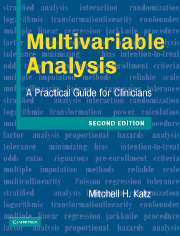Book contents
- Frontmatter
- Contents
- Preface
- 1 Introduction
- 2 Common uses of multivariable models
- 3 Outcome variables in multivariable analysis
- 4 Type of independent variables in multivariable analysis
- 5 Assumptions of multiple linear regression, multiple logistic regression, and proportional hazards analysis
- 6 Relationship of independent variables to one another
- 7 Setting up a multivariable analysis
- 8 Performing the analysis
- 9 Interpreting the analysis
- 10 Checking the assumptions of the analysis
- 11 Propensity scores
- 12 Correlated observations
- 13 Validation of models
- 14 Special topics
- 15 Publishing your study
- 16 Summary: Steps for constructing a multivariable model
- Index
8 - Performing the analysis
Published online by Cambridge University Press: 05 July 2011
- Frontmatter
- Contents
- Preface
- 1 Introduction
- 2 Common uses of multivariable models
- 3 Outcome variables in multivariable analysis
- 4 Type of independent variables in multivariable analysis
- 5 Assumptions of multiple linear regression, multiple logistic regression, and proportional hazards analysis
- 6 Relationship of independent variables to one another
- 7 Setting up a multivariable analysis
- 8 Performing the analysis
- 9 Interpreting the analysis
- 10 Checking the assumptions of the analysis
- 11 Propensity scores
- 12 Correlated observations
- 13 Validation of models
- 14 Special topics
- 15 Publishing your study
- 16 Summary: Steps for constructing a multivariable model
- Index
Summary
What numbers should I assign for dichotomous or ordinal variables in my analysis?
Let's take the simplest case of a dichotomous independent variable based on an interview question: Do you have a history of diabetes: yes or no?
The equations used to solve multivariable analysis need numerical representations of yes and no. Since this scale only has two points, the numeric distance between the two points can be represented by any two numbers that are separated by one: 0 and 1, 1 and 2, 0 and −1, etc. It doesn't really matter. The sign of the coefficient may change depending on whether you assign “yes” the higher or the lower value, but the coefficient and significance level will be the same (Section 9.3). However, you will not get the same answer if you code your variables such that there is more than one point between the two numbers. For example, coding schemes like +1 and −1 will give you a different answer because there is more than one unit between the two points.
Although any two numbers that are one number apart will give you the same answer, a sensible convention, for both independent and dependent variables, is to use 1 and 0, with 1 representing the presence and 0 representing the absence of the condition. This convention is easy to remember and decreases the chance that you will be confused at the direction of the effect.
Information
- Type
- Chapter
- Information
- Multivariable AnalysisA Practical Guide for Clinicians, pp. 96 - 116Publisher: Cambridge University PressPrint publication year: 2006
